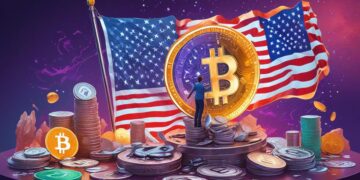The use of NFTs to promote the electronic music sector in the United States

Impact of NFTs in the Electronic Music Scene
The integration of Non-Fungible Tokens (NFTs) into the electronic music industry presents multifaceted benefits for artists and fans alike. One of the primary ways this technology is making an impact is through the creation of direct revenue streams. Artists can now sell digital collectibles, exclusive tracks, and unique content directly to their fanbase without the need for intermediaries, which not only increases their earnings but also allows for a more personal connection with supporters.
Additionally, fan engagement is significantly enhanced through NFTs. Fans can acquire ownership of rare digital assets, such as album art or unreleased tracks, giving them a sense of connection and loyalty to the artist. For instance, a producer might release a limited edition remix as an NFT, allowing a select group of fans to own a piece of their unique sound. This ownership transforms fans from passive listeners to active participants in an artist’s journey.
Another notable advantage is the capacity of NFTs to provide ownership and provenance. Each NFT is recorded on a blockchain, offering verifiable ownership records that confirm the authenticity and uniqueness of the digital asset. For artists, this not only elevates the perceived value of their music but also secures their rights against piracy and unauthorized reproductions. With increasingly rare digital music assets, artists can create demand similar to physical collectibles.
Key Facets of NFT Utilization
As artists embrace NFTs, there are several key facets to consider that enhance their creative outreach:
- Exclusive Releases: Artists can offer limited edition tracks or remixes available only as NFTs, driving urgency and interest among fans eager to collect rare items.
- Virtual Concerts: Tickets and access passes sold as NFTs give fans exclusive entry to digital events, which has become a prevalent model, especially highlighted during the pandemic when live concerts were curtailed.
- Collaborative Projects: Joint ventures among multiple artists lead to enriched content offerings, expanding both their reach and fanbase through shared audiences. For instance, two popular DJs could collaborate on a track and mint it as a joint NFT, creating buzz across their respective platforms.
In conclusion, as the electronic music landscape evolves, NFTs represent a groundbreaking shift that fosters not only financial stability for artists but also enriches fan experiences. By adopting this technology, artists in the United States can elevate their artistry, connect more intimately with their fans, and redefine the economics of music production in a rapidly changing digital age.
SEE ALSO: Click here to read another article
The Potential of NFTs for Electronic Music Artists
In the rapidly evolving landscape of digital commerce, Non-Fungible Tokens (NFTs) are emerging as a lucrative avenue for electronic music artists in the United States. These unique digital assets not only provide a new stream of revenue but also promise enhanced engagement with fans. To successfully incorporate NFTs into their promotional strategies, artists should take a series of strategic steps.
1. Identify Unique Content
Artists should begin by assessing their existing catalog to pinpoint content that stands out as exclusive or specially curated. This may consist of rare tracks that never made it to mainstream releases, unreleased remixes, or behind-the-scenes recordings from studio sessions. Additionally, artists can consider creating digital art that visualizes their music or reflects the themes of their albums. The uniqueness of these offerings encourages fans to invest in these digital assets, as they offer something that can’t be found elsewhere.
2. Choose a Marketplace
After identifying the unique content, the next step is to select an appropriate NFT marketplace to list these digital assets. Popular platforms like OpenSea, Rarible, and Foundation each offer distinct features and target audiences. For instance, OpenSea has a wide range of options and is highly accessible, while Foundation focuses on curated art, which can be beneficial for artists looking to enhance their reputation within the art community. Understanding the fee structures and audience dynamics of each platform can significantly impact visibility and sales.
3. Minting the NFTs
The minting process transforms digital files into NFTs and is a crucial step. Artists must first create a digital wallet, such as MetaMask, and link it to their chosen marketplace. Following the on-screen instructions allows artists to upload their digital asset and mint it into an NFT. Providing detailed descriptions and emphasizing the exclusivity of the offering can attract potential buyers and increase bids. For instance, stating the number of limited editions available or adding personal anecdotes can enhance the emotional appeal.
4. Utilize Social Media for Promotion
Promotion via social media is vital for generating interest in NFT releases. Platforms like Twitter, Instagram, and TikTok allow artists to share teasers and countdowns to build anticipation. Engaging stories about the artistic process or the meaning behind each NFT can captivate the audience. Using dedicated hashtags can also broaden outreach. For instance, artists can use #NFTmusic or #CryptoArt to connect with a larger community interested in NFTs.
5. Engage with NFT Collectors
Building a network within the NFT community is essential for sustained success. Artists should actively engage with potential collectors by participating in discussions, hosting webinars, or collaborating with established NFT projects. This interaction not only cultivates loyalty among fans but also encourages more people to invest in the artist’s offerings. For example, joining existing NFT communities on Discord can facilitate direct conversations with collectors and fellow musicians.
6. Establish a Regular Release Schedule
Maintaining a schedule for releasing NFTs can generate ongoing interest and engagement. Consider launching exclusive digital tracks or limited-edition artwork monthly. This strategy creates a sense of anticipation, keeping fans actively involved with the artist’s journey and enhancing digital collectability.
In summary, NFTs are revolutionizing profit opportunities for electronic musicians. By following these steps and adapting to changes in the digital market, artists can leverage the full potential of this innovative technology, which not only boosts their careers but also deepens connections with their audiences.
SEE ALSO: Click here to read another article
Navigating Challenges and Future Opportunities
While the potential of NFTs in the electronic music sector is significant, artists must also navigate various challenges to fully capitalize on this digital trend. Understanding these hurdles and implementing strategies to address them can facilitate greater success.
7. Understand the Legal Landscape
The legality surrounding NFTs is complex and evolving. Artists should familiarize themselves with copyright issues related to their digital assets. It’s crucial to ensure that any content being minted as an NFT does not infringe on existing copyrights. Consulting with a legal expert specializing in digital rights can prevent potential disputes and safeguard artists’ work. Moreover, it may be beneficial to establish clear terms of sale, articulating the rights and obligations of both the artist and the buyer.
8. Diversify Offerings Beyond Music
Expanding NFT offerings to include various formats can attract a broader audience. In addition to exclusive tracks, consider producing limited-edition merchandise, such as custom visual art inspired by your music. For instance, NFT collectors appreciate bundled packages that may include concert tickets or backstage passes, effectively combining digital assets with real-world experiences. This approach not only generates revenue but can foster a deeper connection with fans.
9. Leverage Collaborations
Collaborations with other artists or brands can enhance visibility and appeal within the NFT space. Joining forces with established NFT creators can introduce an artist to a wider audience and legitimize their presence in the market. For example, electronic artists may collaborate with digital visual artists to produce multimedia NFT experiences that showcase both music and visual aesthetics, thus engaging a diverse range of fans.
10. Track Performance and Adjust Strategies
Continuous monitoring of NFT sales and audience engagement is crucial to refine promotional strategies effectively. Utilize analytics tools available on NFT marketplaces to track which types of content perform well and adjust future releases accordingly. For instance, if certain genres or collaboration styles yield higher engagement, artists can pivot their efforts to focus on these areas. Regularly soliciting feedback from fans can also provide valuable insights.
11. Participation in Blockchain Communities
Immersing oneself in blockchain and NFT communities has become an invaluable strategy for artists seeking to promote their music. Platforms such as Telegram or Discord can serve as spaces for artists to network, learn from industry leaders, and promote their NFTs. Engaging actively in these communities allows artists to gain insights on upcoming trends, participate in discussions, and directly interact with potential buyers.
12. Address Environmental Concerns
Given the environmental impact often associated with blockchain technology, artists should consider conducting thorough research to select eco-friendly platforms. The rise of green NFTs, which utilize less energy-intensive networks, can bolster an artist’s image and appeal to environmentally conscious fans. Adopting sustainable practices demonstrates a commitment to social responsibility, enhancing overall brand value.
By understanding the complexities of the NFT landscape, artists can navigate challenges while opening new avenues for growth within the electronic music sector. Future opportunities lie not just in the sales of digital assets, but in the creation of lasting relationships with fans who are eager to support their favorite artists in innovative ways.
CHECK OUT: Click here to explore more
Conclusion
The integration of NFTs within the electronic music sector presents a unique opportunity for artists to engage with their fans and monetize their work in innovative ways. By embracing this technology, musicians can not only diversify their income streams but also create a deeper connection with their audience through exclusive and interactive digital experiences.
To maximize the potential of NFTs, artists should take decisive steps. First, stay informed about the legal implications of creating NFTs to protect their work and ensure compliance. Second, broaden their offerings beyond music by including merchandise or experience bundles that appeal to fans. Third, collaborate with other artists or brands to expand reach and add value to their NFT projects. Additionally, monitoring performance analytics will allow artists to make data-driven decisions and adapt to audience preferences.
Moreover, actively participating in blockchain communities can provide insights and foster relationships that are essential for establishing a robust presence in the NFT market. Artists must also be conscious of environmental concerns and choose eco-friendly platforms to align with the values of their audience.
In summary, by strategically leveraging NFTs, electronic musicians in the United States can open up new avenues for artistic expression and revenue generation. With the right tools and a proactive approach, the future of electronic music can be enriched and sustainably transformed in the digital age.

James Carter is a financial writer and consultant with expertise in economics, personal finance, and investment strategies. With years of experience helping individuals and businesses navigate complex financial decisions, James provides practical insights and analysis. His goal is to empower readers with the knowledge they need to achieve financial success.





